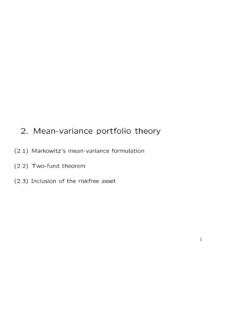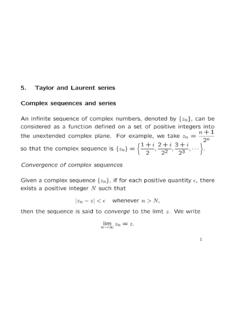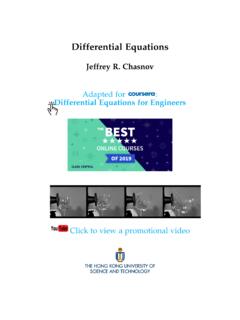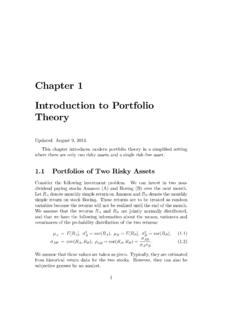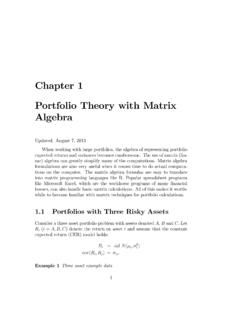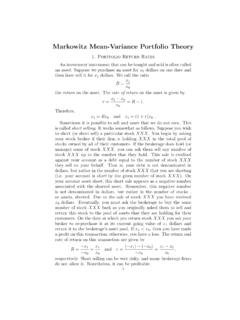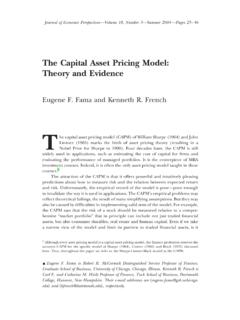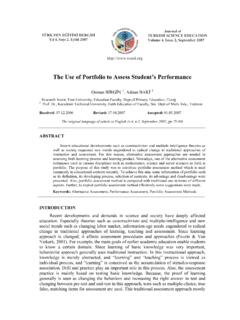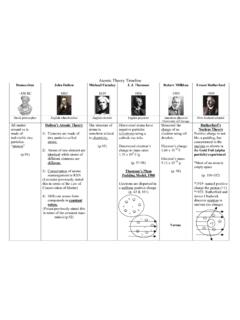Transcription of Portfolio Selection Harry Markowitz The Journal of Finance ...
1 Portfolio Selection Harry Markowitz The Journal of Finance , Vol. 7, No. 1. (Mar., 1952), pp. 77-91. Stable URL: The Journal of Finance is currently published by American Finance Association. Your use of the JSTOR archive indicates your acceptance of JSTOR's Terms and Conditions of Use, available at JSTOR's Terms and Conditions of Use provides, in part, that unless you have obtained prior permission, you may not download an entire issue of a Journal or multiple copies of articles, and you may use content in the JSTOR archive only for your personal, non-commercial use. Please contact the publisher regarding any further use of this work. Publisher contact information may be obtained at Each copy of any part of a JSTOR transmission must contain the same copyright notice that appears on the screen or printed page of such transmission. The JSTOR Archive is a trusted digital repository providing for long-term preservation and access to leading academic journals and scholarly literature from around the world.
2 The Archive is supported by libraries, scholarly societies, publishers, and foundations. It is an initiative of JSTOR, a not-for-profit organization with a mission to help the scholarly community take advantage of advances in technology. For more information regarding JSTOR, please contact Mon Sep 3 01:12:50 2007. Portfolio Selection *. Harry . Markowitz . The Rand Corporation THEPROCESS OF SELECTING a Portfolio may be divided into two stages. The first stage starts with observation and experience and ends with beliefs about the future performances of available securities. The second stage starts with the relevant beliefs about future performances and ends with the choice of Portfolio . This paper is concerned with the second stage. We first consider the rule that the investor does (or should). maximize discounted expected, or anticipated, returns.
3 This rule is re- jected both as a hypothesis to explain, and as a maximum to guide in- vestment behavior. We next consider the rule that the investor does (or should) consider expected return a desirable thing and variance of re- turn an undesirable thing. This rule has many sound points, both as a maxim for, and hypothesis about, investment behavior. We illustrate geometrically relations between beliefs and choice of Portfolio accord- ing to the "expected returns-variance of returns" rule. One type of rule concerning choice of Portfolio is that the investor does (or should) maximize the discounted (or capitalized) value of future Since the future is not known with certainty, it must be "expected" or "anticipatded7'returns which we discount. Variations of this type of rule can be suggested. Following Hicks, we could let "anticipated" returns include an allowance for Or, we could let the rate at which we capitalize the returns from particular securities vary with risk.
4 The hypothesis (or maxim) that the investor does (or should). maximize discounted return must be rejected. If we ignore market im- perfections the foregoing rule never implies that there is a diversified Portfolio which is preferable to all non-diversified portfolios. Diversi- fication is both observed and sensible; a rule of behavior which does not imply the superiority of diversification must be rejected both as a hypothesis and as a maxim. * This paper is based on work done by the author while a t the Cowles Commission for Research in Economics and with the financial assistance of the Social Science Research Council. I t will be reprinted as Cowles Commission Paper, New Series, No. 60. 1. See, for example, J. B. Williams, The Theory of Investment Value (Cambridge, Mass.: Harvard University Press, 1938), pp. 55-75. 2. J. R. Hicks, V a l ~ aend Capital (New York: Oxford University Press, 1939), p.
5 126. Hicks applies the rule to a firm rather than a Portfolio . 78 The Journal of Finance The foregoing rule fails to imply diversification no matter how the anticipated returns are formed; whether the same or different discount rates are used for different securities; no matter how these discount rates are decided upon or how they vary over The hypothesis implies that the investor places all his funds in the security with the greatest discounted value. If two or more securities have the same val- ue, then any of these or any combination of these is as good as any other. We can see this analytically: suppose there are N securities; let rit be the anticipated return (however decided upon) at time t per dollar in- vested in security i; let djt be the rate at which the return on the ilk security at time t is discounted back to the present; let X i be the rela- tive amount invested in security i.
6 We exclude short sales, thus Xi 2 0. for all i . Then the discounted anticipated return of the Portfolio is Ri = x m t-1. di, T i t is the discounted return of the ithsecurity, therefore R = ZXiRi where Ri is independent of Xi. Since Xi 2 0 for all i and Z X i = 1, R is a weighted average of Ri with the X i as non-nega- tive weights. To maximize R, we let Xi = 1 for i with maximum Ri. If several Ra,, a = 1, .. , K are maximum then any allocation with maximizes R. In no case is a diversified Portfolio preferred to all non- diversified poitfolios. I t will be convenient a t this point to consider a static model. In- stead of speaking of the time series of returns from the ith security ( r i l , ri2) .. , rit, ..) we will speak of "the flow of returns" (ri) from the ithsecurity. The flow of returns from the Portfolio as a whole is 3. The results depend on the assumption that the anticipated returns and discount rates are independent of the particular investor's Portfolio .
7 4. If short sales were allowed, an infinite amount of money would be placed in the security with highest r . Portfolio Selection 79. R = ZX,r,. As in the dynamic case if the investor wished to maximize "anticipated" return from the Portfolio he would place all his funds in that security with maximum anticipated returns. There is a rule which implies both that the investor should diversify and that he should maximize expected return. The rule states that the investor does (or should) diversify his funds among all those securities which give maximum expected return. The law of large numbers will insure that the actual yield of the Portfolio will be almost the same as the expected rule is a special case of the expected returns- variance of returns rule (to be presented below). I t assumes that there is a Portfolio which gives both maximum expected return and minimum variance, and it commends this Portfolio to the investor.
8 This presumption, that the law of large numbers applies to a port- folio of securities, cannot be accepted. The returns from securities are too intercorrelated. Diversification cannot eliminate all variance. The Portfolio with maximum expected return is not necessarily the one with minimum variance. There is a rate a t which the investor can gain expected return by taking on variance, or reduce variance by giv- ing up expected return. We saw that the expected returns or anticipated returns rule is in- adequate. Let us now consider the expected returns-variance of re- turns (E-V) rule. I t will be necessary to first present a few elementary concepts and results of mathematical statistics. We will then show some implications of the E-V rule. After this we will discuss its plausi- bility. In our presentation we try to avoid complicated mathematical state- ments and proofs.
9 As a consequence a price is paid in terms of rigor and generality. The chief limitations from this source are (1) we do not derive our results analytically for the n-security case; instead, we present them geometrically for the 3 and 4 security cases; (2) we assume static probability beliefs. In a general presentation we must recognize that the probability distribution of yields of the various securities is a function of time. The writer intends to present, in the future, the gen- eral, mathematical treatment which removes these limitations. We will need the following elementary concepts and results of mathematical statistics: Let Y be a random variable, , a variable whose value is decided by chance. Suppose, for simplicity of exposition, that Y can take on a finite number of values yl, yz, .. , y,~.Let the probability that Y =. 5. U'illiams, o p.
10 Cit., pp. 68, 69. 80 T h e Journal of Finance yl, be pl; that Y = y2 be pz etc. The expected value (or mean) of Y is defined to be The variance of Y is defined to be V is the average squared deviation of Y from its expected value. V is a commonly used measure of dispersion. Other measures of dispersion, closely related to V are the standard deviation, u = .\/V and the co- efficient of variation, a/E. Suppose we have a number of random variables: R1, .. , R,. If R is a weighted sum (linear combination) of the Ri then R is also a random variable. (For example R1, may be the number which turns up on one die; R2, that of another die, and R the sum of these numbers. In this case n = 2, a1 = a2 = 1). It will be important for us to know how the expected value and variance of the weighted sum (R) are related to the probability dis- tribution of the R1.
